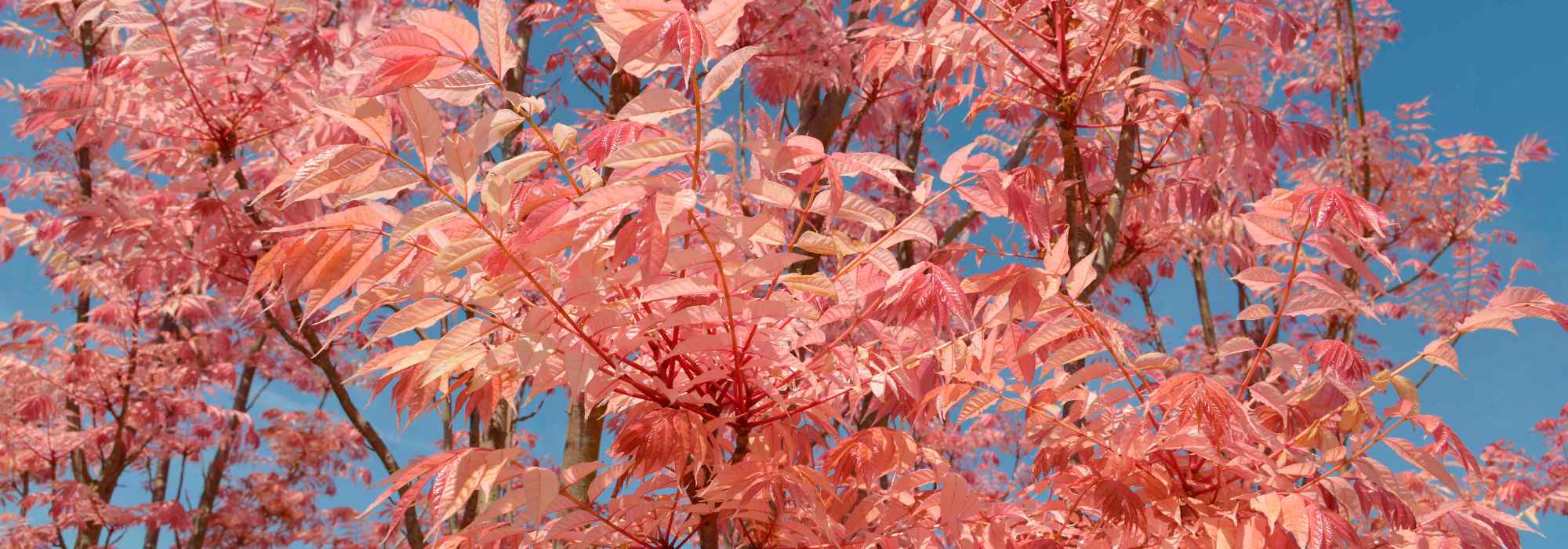
Toona sinensis or Chinese mahogany: planting and growing
Contents
Toona sinensis in a few words
- The Toona sinensis is a tree native to East Asia, primarily China, but also found in Korea and Australia. It thrives in temperate and subtropical climates.
- This beautiful tree, the type species, can reach up to 25 metres in height in the wild, slightly less in our gardens.
- It has deciduous foliage, composed of large pinnate leaves, and produces fragrant white flowers in clusters.
- Valued for its generous shade and aromatic foliage, the Toona sinensis is often used in parks and large gardens.
- The Chinese Mahogany requires well-drained soil and a sunny to partially shaded exposure.
The word from our expert
Few trees fascinate me as much as the Toona sinensis, or Chinese Mahogany. This majestic tree, native to the temperate forests of Asia, is a true botanical treasure for any garden.
The Toona sinensis, or Chinese Cedar, captivates with its natural elegance. Its pinnate leaves, which can grow up to a metre long, emit a pleasant and distinctive scent when crushed. Their colour ranges from soft green in spring to a vibrant red in autumn, offering a striking visual spectacle.
Among the cultivars, the Toona ‘Flamingo’ stands out particularly. Its young leaves display shades of pink, cream, and green, adding a unique splash of colour to the garden. This cultivar, less imposing than the species type, adapts wonderfully to medium-sized gardens.
To cultivate the Toona sinensis, I recommend a rich, well-drained soil. Although it enjoys the sun, light shade during the hottest hours promotes optimal growth.
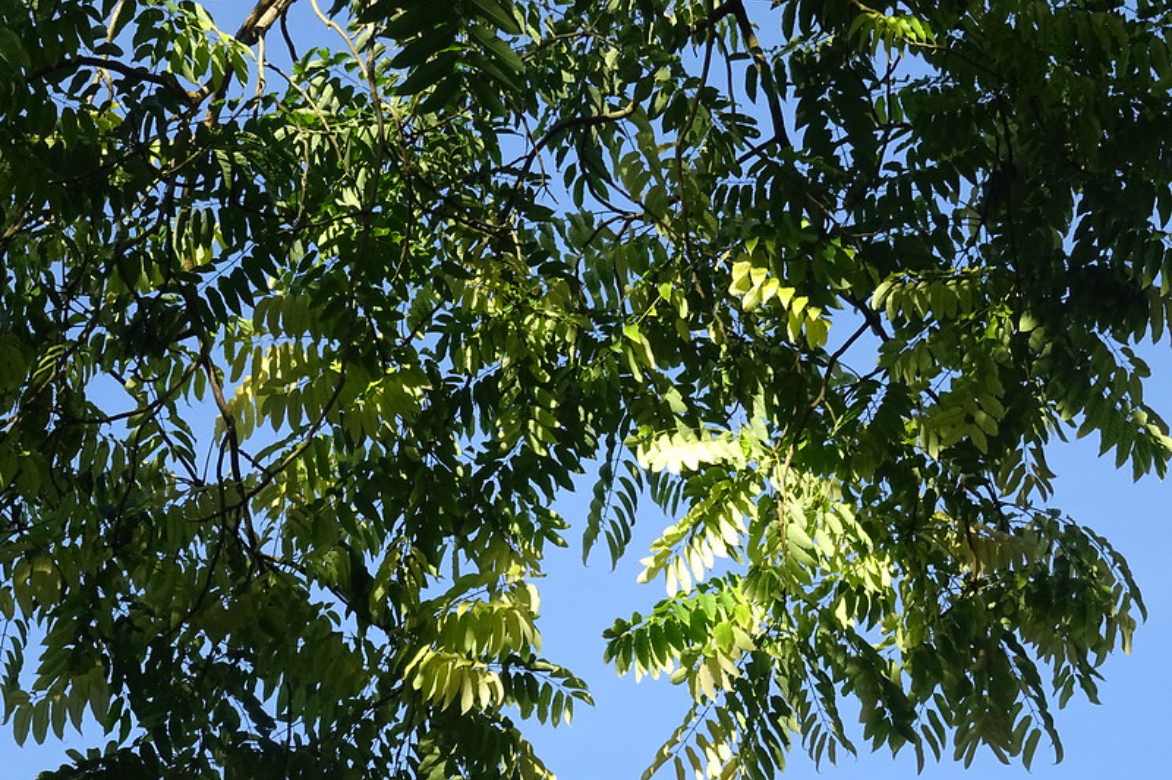
Toona sinensis (© Olive Titus)
Did you know that the young leaves of the Toona sinensis are a prized ingredient in Asian cuisine? They add a unique flavour to dishes. Moreover, this tree has a rich history; it was considered a symbol of longevity and prosperity in ancient China.
In short, don’t wait any longer and welcome a Toona into your home, preferably the stunning ‘Flamingo’ cultivar.
Botany and description
Botanical data
- Latin name Toona sinensis
- Family Meliaceae
- Common name Chinese Mahogany, Chinese Cedar
- Flowering May to June
- Height over 10 m
- Exposure sun or partial shade
- Soil type rich and moist, but well-drained
- Hardiness -15°C
The genus Toona, which includes several species, the most well-known being Toona sinensis, belongs to the Meliaceae family. This genus comprises five species and is distinguished by its extensive geographical distribution, ranging from Southeast Asia to Australia.
- Toona calantas or Philippine Cedar
- Toona ciliata or Australian Red Cedar (synonym: Toona australis)
- Toona febrifuga or Vietnamese Cedar
- Toona sinensis or Chinese Mahogany (or Chinese Cedar): hardy down to -15°C
- Toona sureni or Indonesian Cedar
The scientific name of the genus Toona derives from its indigenous Australian name. The species of the Toona genus are primarily distributed in Southeast Asia, India, Australia, and certain regions of the Himalayas. Toona sinensis, or Chinese Mahogany, the only one cultivated here due to its hardiness, originates from China and East Asia. There is some confusion regarding the naming of this tree, referred to in various sources as Toona sinensis, Cedrela toona, or Cedrela sinensis. However, the genus Cedrela, exclusively American, is now separated from the genus Toona, which originates from the Old World.
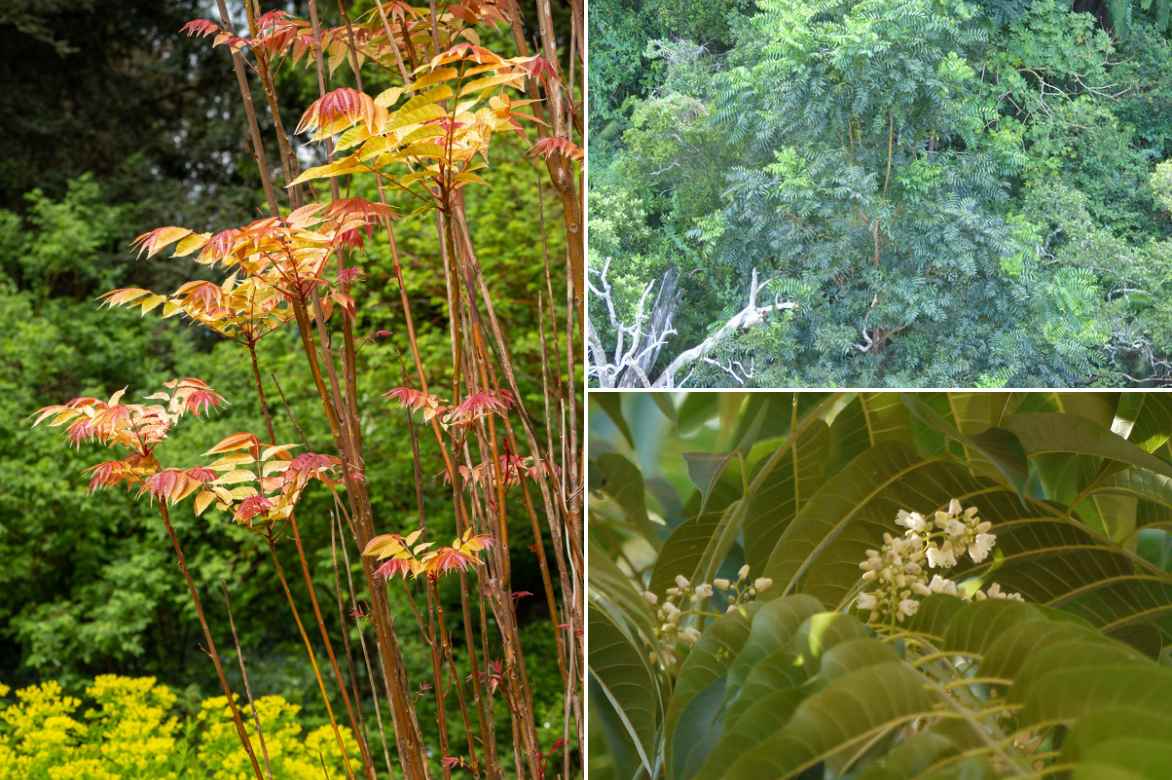
Toona sinensis on the left (© Forest and Kim Starr). On the right, Toona ciliata (© Dinesh Valke)
The trees of the Toona genus exhibit a majestic and slender silhouette, with an often upright habit and a rounded crown. The mature size can vary considerably depending on the species, but some specimens of Toona sinensis can reach up to 25 metres in height. Toona sinensis is particularly known for its relatively rapid growth, especially in its early years. By the age of ten, it can reach a height of 6 to 8 metres.
The bark of Toona trees is generally smooth in young specimens, becoming rougher and fissured with age. Its colour ranges from grey to brown.
The foliage is one of the most remarkable aspects of the Toona genus. The leaves are usually large, pinnate (composed of numerous small leaflets arranged on either side of a central axis or rachis) or bipinnate, measuring up to 60 cm in length. They consist of numerous small oval leaflets, dark green on the upper side and lighter underneath. In autumn, the leaves of Toona sinensis transform into a spectacle of vibrant colours. They shift from deep green in summer to a range of spectacular autumnal hues, from golden yellow to bright red, including shades of orange and copper.
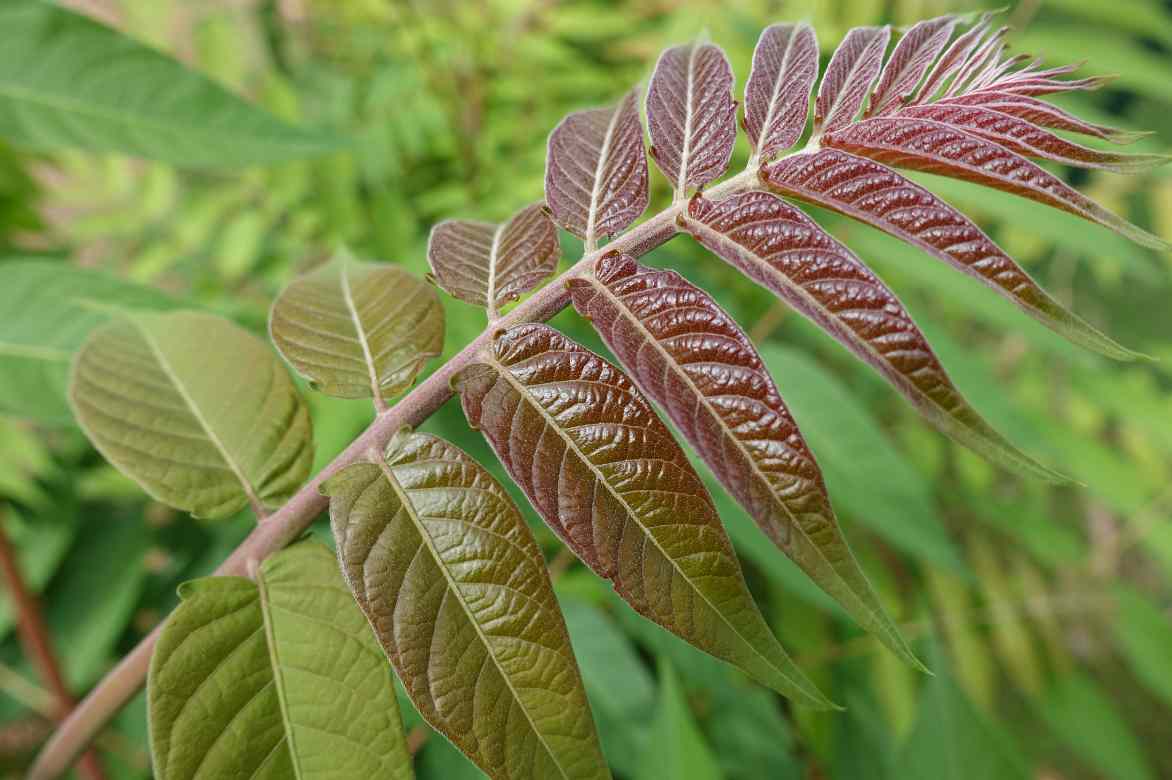
The leaves display magnificent hues throughout the year
The trees of the Toona genus produce small white or pink flowers, clustered in racemes or panicles. The flowering of Toona sinensis in particular occurs between May and June. The flowers of the Chinese Mahogany are small but appear in large quantities. They are typically white, cream, or sometimes slightly pink. Each flower consists of five delicate petals and numerous prominent stamens. These flowers are grouped into long panicles or racemes that can reach several tens of centimetres in length. These pendulous clusters give the tree a highly ornamental appearance when in full bloom. One of the most remarkable aspects of the flowering of Toona sinensis is its fragrance. The flowers emit a sweet and pleasant aroma, often described as subtly sugary. This scent attracts various pollinators, including bees and butterflies, which are essential for the tree’s pollination. When the tree is in full bloom, it transforms into a spectacular mass of white flowers, offering a striking contrast against its dark green foliage.
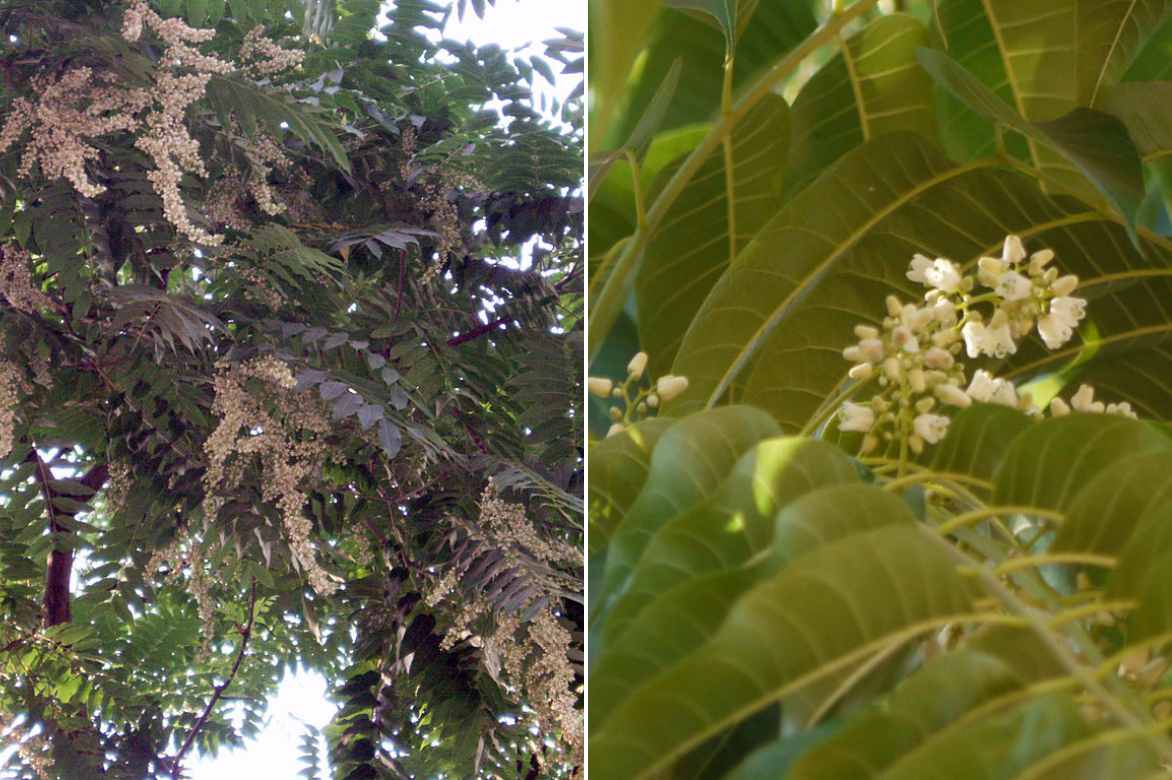
On the left, flowering of a Toona sinensis (©Fanghong -Wikimedia Commons); on the right, Toona ciliata (© Dinesh Valke)
The fruits of Toona are woody capsules that open to release numerous small winged seeds. These seeds are dispersed by the wind, facilitating the natural propagation of the species.
The Toona species typically prefer well-drained and fertile soils, but some can tolerate a variety of soil types, including less fertile ones. Their root system is adapted to efficiently exploit water and nutrients. The root system of Toona sinensis is generally extensive and robust, suited to support its large size and height. It is a mixed root system, combining deep taproots for stability and anchoring, and widespread lateral roots for efficient absorption of water and nutrients.
The most well-known species and varieties
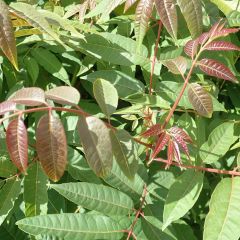
Toona sinensis - Chinese Mahogany
- Flowering time June to August
- Height at maturity 18 m
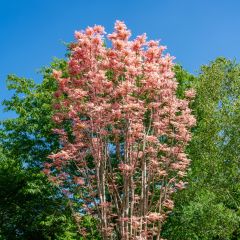
Toona sinensis Flamingo - Chinese Mahogany
- Flowering time June, July
- Height at maturity 10 m
Planting Toona sinensis
When to Plant?
Autumn planting is often considered ideal, especially in temperate climates. Planting during this period allows the tree to establish itself during the cool, damp months of autumn before entering winter dormancy.
Early spring, after the last frost, is also a good time to plant Toona sinensis. However, it is then important to ensure adequate watering during the summer months for young plants.
Where to Plant?
How to Plant?
- Dig a hole twice as wide as the root ball and as deep as the container in which the tree arrived.
- Enhance the removed soil with compost or well-rotted manure if necessary, especially if the soil is poor.
- Remove the tree from the container carefully. If the tree is delivered with a root ball wrapped in burlap, loosen the burlap at the collar and plant it all without disturbing the root ball.
- Place the tree in the hole so that the top of the root ball is level with the surrounding soil.
- Fill the hole with the amended soil, lightly firming it to eliminate air pockets.
- Water thoroughly to help establish contact between the roots and the soil.
Important! A well-established tree will tolerate short frosts of around -12 to -15°C. For the first few winters, install a thick winter fleece if very low temperatures are forecast.
Maintenance of Toona sinensis
Regular watering is essential, especially during the first few years and in periods of drought, ensuring the soil remains moist but not waterlogged. It is recommended to apply an organic mulch around the base to retain moisture and control weeds.
Pruning is generally unnecessary, except to remove dead or misplaced branches, and should be carried out in late winter or early spring.
Diseases and parasitic pests
The Toona genus cedars are relatively resistant to diseases and parasitic issues. However, the Toona sinensis can be susceptible to attacks from aphids and scale insects, which can weaken the tree and reduce its vigour. Fungal diseases, such as root rot or powdery mildew, may also develop, particularly in poorly drained soil or high humidity conditions.
Propagating a Toona
The most effective method to propagate Toona sinensis is by sowing. The seeds should be harvested at ripeness, typically in autumn, and can be sown immediately or after cold stratification if stored. To optimise germination, the seeds should be planted in a well-drained substrate and kept in moist, but not waterlogged, conditions. The ideal temperature for germination is around 20°C. The young plants require attentive care until they are robust enough to be transplanted to their final location.
Note: To faithfully propagate a variety like Toona sinensis ‘Flamingo’, it is preferable to use vegetative propagation methods such as propagation by cuttings or, even better, grafting rather than sowing.
Association
Anecdotes
- The “Toona” in cuisine: The young leaves of Toona sinensis are consumed in China and known as ‘xiangchun’. They are used to flavour dishes and are particularly prized in spring, often stir-fried with garlic or incorporated into omelettes, offering a unique taste reminiscent of onion.
- A symbol of longevity: In China, Toona sinensis is considered a symbol of longevity and prosperity. This may be due to its long lifespan and imposing stature, as well as its traditional uses in medicine.
- Quality wood for instruments: The wood of Toona sinensis is highly valued for making traditional Chinese musical instruments. Its fine texture and ability to produce good sound make it a material of choice for luthiers.
- Medicinal plant: In traditional Chinese medicine, Toona sinensis is used for its medicinal properties. It is believed to have beneficial effects on the blood and the body’s internal balance.
- A tree for generations: Some Toona sinensis are planted as birth trees in China, where a tree is planted at the birth of a child and grows with them. This symbolises the child’s growth and development.
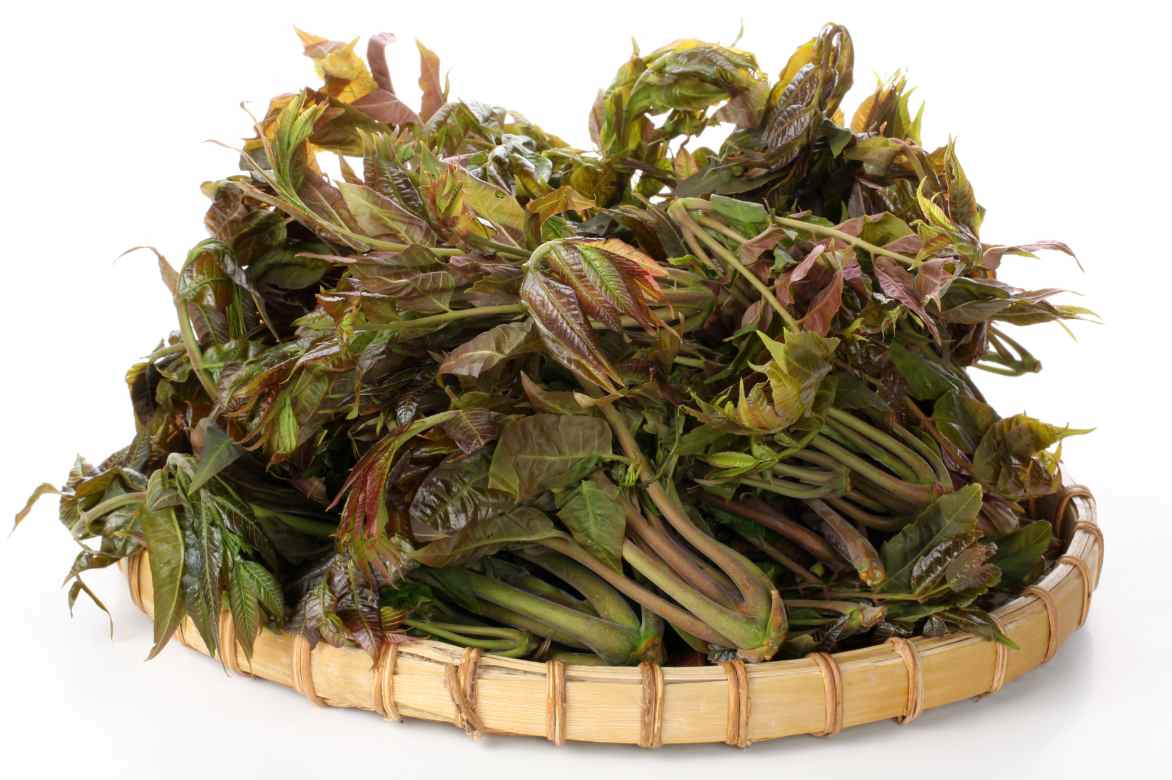
In Asia, the young shoots are used in cuisine
To go further...
Discover other rare trees and bushes from our collections in our online nursery.
A fan of pink foliage? Explore our selection of trees and bushes with pink foliage.
Please note: A tree resembling the Toona sinensis is the Ailanthus altissima or glandulous Ailanthus. The latter has an invasive character and threatens many ecosystems in Europe. This is why it is no longer available for sale. You can replace this invasive essential oil advantageously with a Toona, which is far less problematic.
- Subscribe!
- Contents
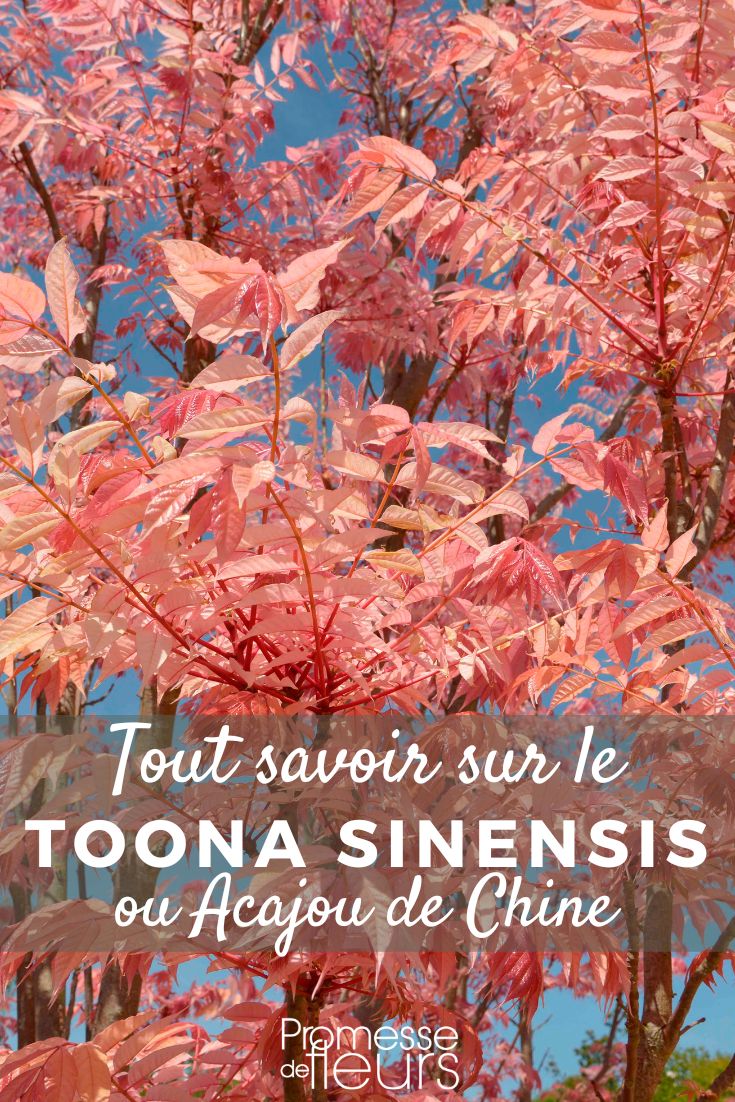































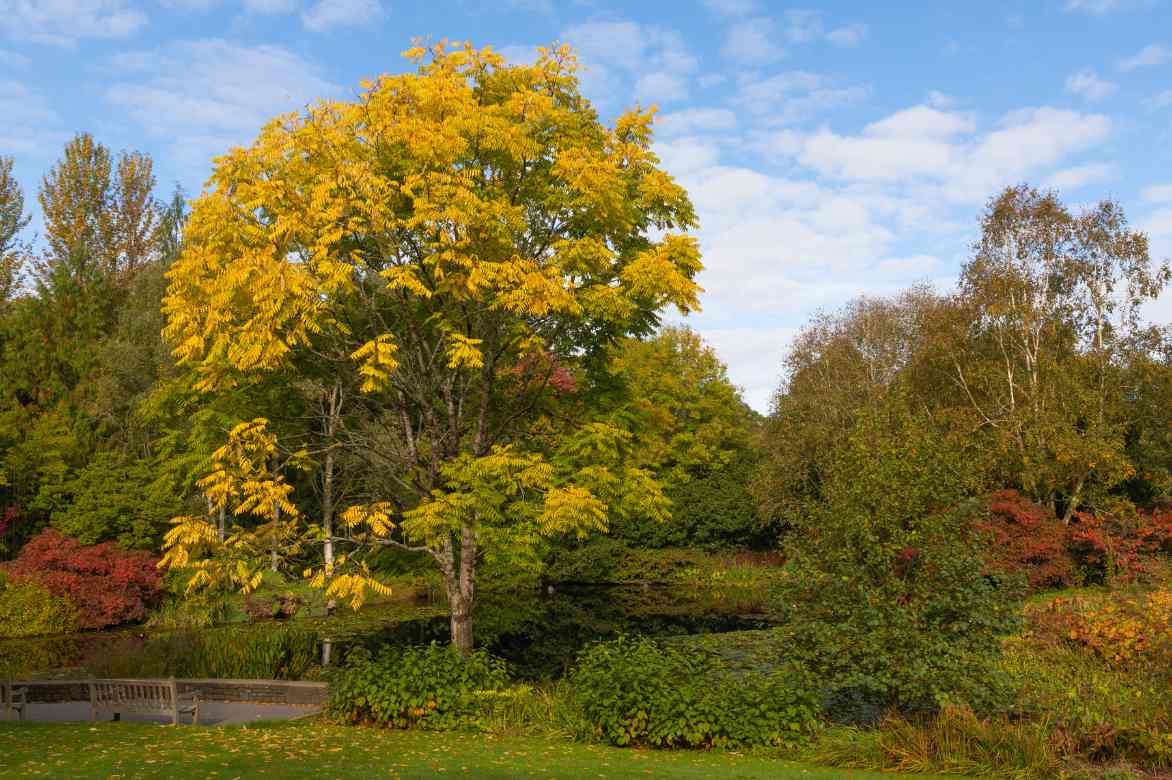
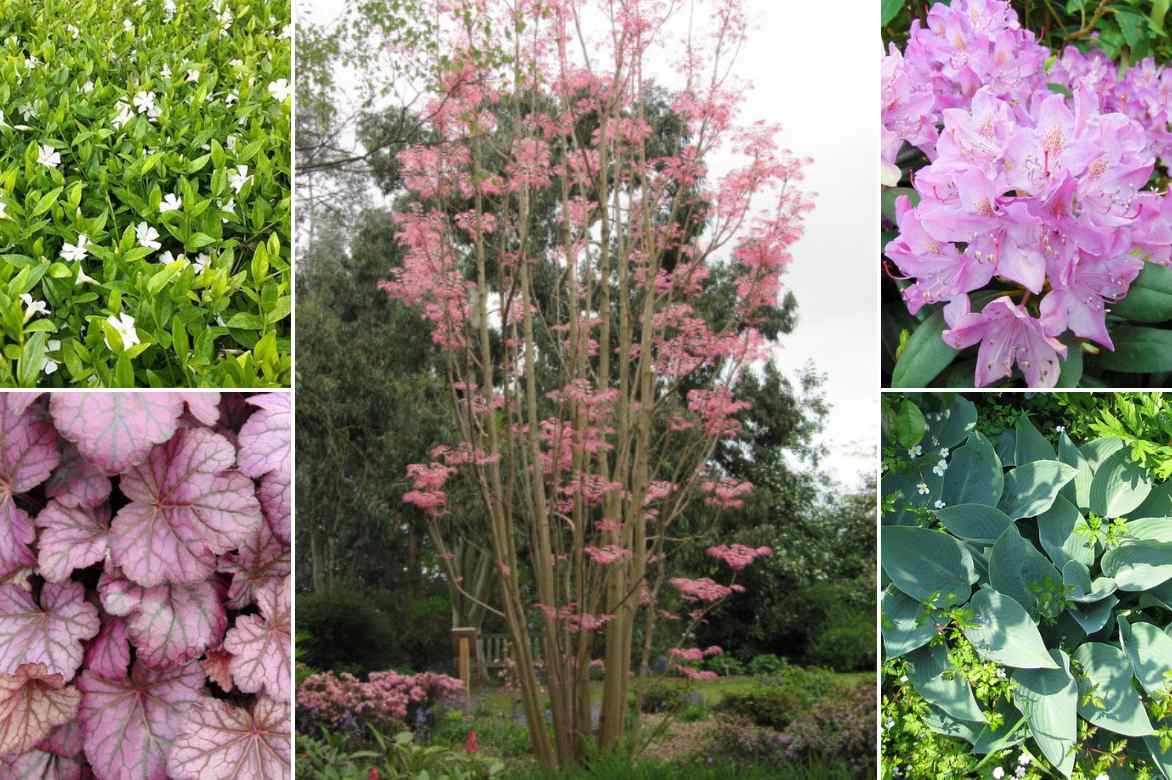
Comments